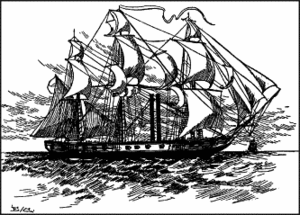PS Rising Star
PS Rising Star was a paddle steamer warship, nicknamed the Rising Sun. The ship was seen as a revolutionary design[2] that included twin funnels and an internal retractable paddle wheel. She was the first ever British steam warship to cross the Atlantic from east to west in 1821.[3]
 Rising Star | |
| History | |
|---|---|
| Name: | Rising Star |
| Builder: | Blent's Yard, Rotherhithe, UK |
| Launched: | 1818 |
| Fate: | Sank 1830 |
| Notes: | First steam warship ever built[1] |
| General characteristics | |
| Displacement: | 410 tonnes (400 long tons; 450 short tons) |
| Propulsion: | 70 hp (52 kW) |
| Armament: | 20 guns |
Rising Star was built in Rotherhithe for Thomas Cochrane (later tenth Earl of Dundonald).[4] Cochrane's reputation as a skilled naval commander led him to construct a warship that aimed to eliminate the differences in capability between the Chilean and the Spanish naval forces.[4] Cochrane intended the vessel to be used as a steam warship within the Chilean War of Independence. He made efforts to conceal the ship's real purpose under the guise that it was to be used to sail to the North Pole.[5]
Propulsion and guns
The PS Rising Star was driven by a centerline paddle wheel powered by 70 horsepower (52 kW) steam engines consisting of twin cylinders which were constructed by Maudslay and Sons and Field.[6]
The prospect of a ship that did not have to depend on the wind for power drew much anticipation from Cochrane and he contributed £3000 of his own money into the venture. Edward Ellice, a South-America trader, supplied £4000.
The Rising Star was inevitably a small warship, but made up for its size as with a conventional battery of twenty guns, which was distributed along its open spar deck, ten in each broadside.[7]
The voyage to Chile
Due to delays in her construction (which took place in Kier's yard in 1820) the Rising Star was not built in time and only ran her trials on the Thames in June 1821. The ship managed six knots under steam.[3][8] Although Cochrane had originally ordered the Rising Star to be constructed, when it was eventually fully finished he did not take the ship out himself; Major Hon. William Cochrane was given this task.[4]
Rising Star had not been properly designed and the engine was too small to propel her. Since the miscalculation could not be easily remedied, Alvarez Condarco, the Chilean Minister in London asked Cochrane to leave for Chile without delay, so that he could take immediate command of the First Chilean Navy Squadron.
Rising Star eventually sailed from Gravesend on 22 October 1821, heading for Valparaíso. Just off the coast of Portugal she sprang a leak and had to be put into dock at Cork for repairs to the hull.[3] Once repaired, Rising Star set off again for Valparaíso and this time made the voyage without interference, arriving on 22 April 1822. This late arrival meant the voyage that was intended to make it in time for the war ended up being six months later.[3][9]
PS Rising Star was eventually sold to Winter y Brittain of Buenos Aires and sank in 1830 in the Irish Sea.[10]
References
- The Coming of Lord Cochrane, retrieved on 21 December 2012
- Brian Vale (15 December 2007). Cochrane in the Pacific: Fortune and Freedom in Spanish America. I.B.Tauris. p. 33. ISBN 978-1-84511-446-6. Retrieved 21 December 2012.
- Deeson, A. F. L. (February 1977). An Illustrated history of Steamships. Buckinghamshire: Spurbooks Ltd. p. 54. ISBN 978-0904978056.
- Fletcher, R. A. (2014). Warships and Their Story. Literary Licensing LLC. ISBN 978-1498108904.
- Brian Vale (15 December 2007). Cochrane in the Pacific: Fortune and Freedom in Spanish America. I.B.Tauris. p. 34. ISBN 978-1-84511-446-6. Retrieved 21 December 2012.
- Dumplington, B; Muriel, M. (2002). The Story of the Paddle Steamer. Venton. pp. 22–23.
- Sondhaus, L. (2001). Naval Warfare, 1815-1914. London: Routledge. pp. 20.
- Villers, A. Pioneers of the Seven Seas. p. 124.
- Dumplington, B; Muriel, M. Brunel's Three Ships. p. 30.
- Chilean Navy site, Estrella Naciente Archived 18 November 2010 at the Wayback Machine, retrieved on 21 December 2012